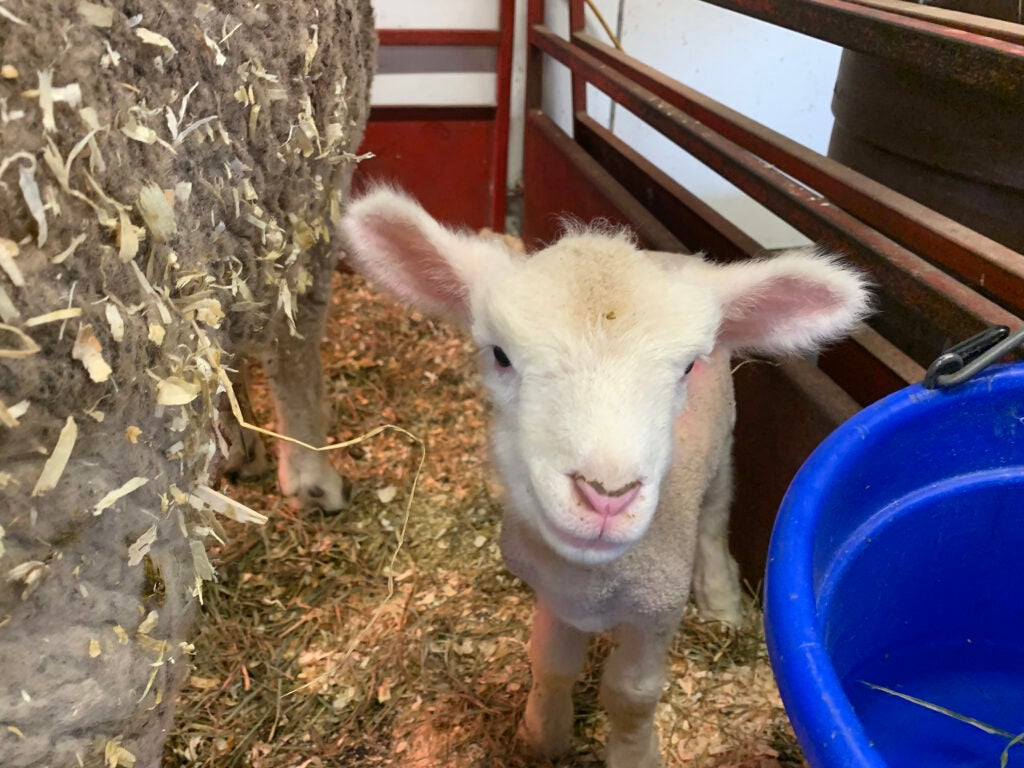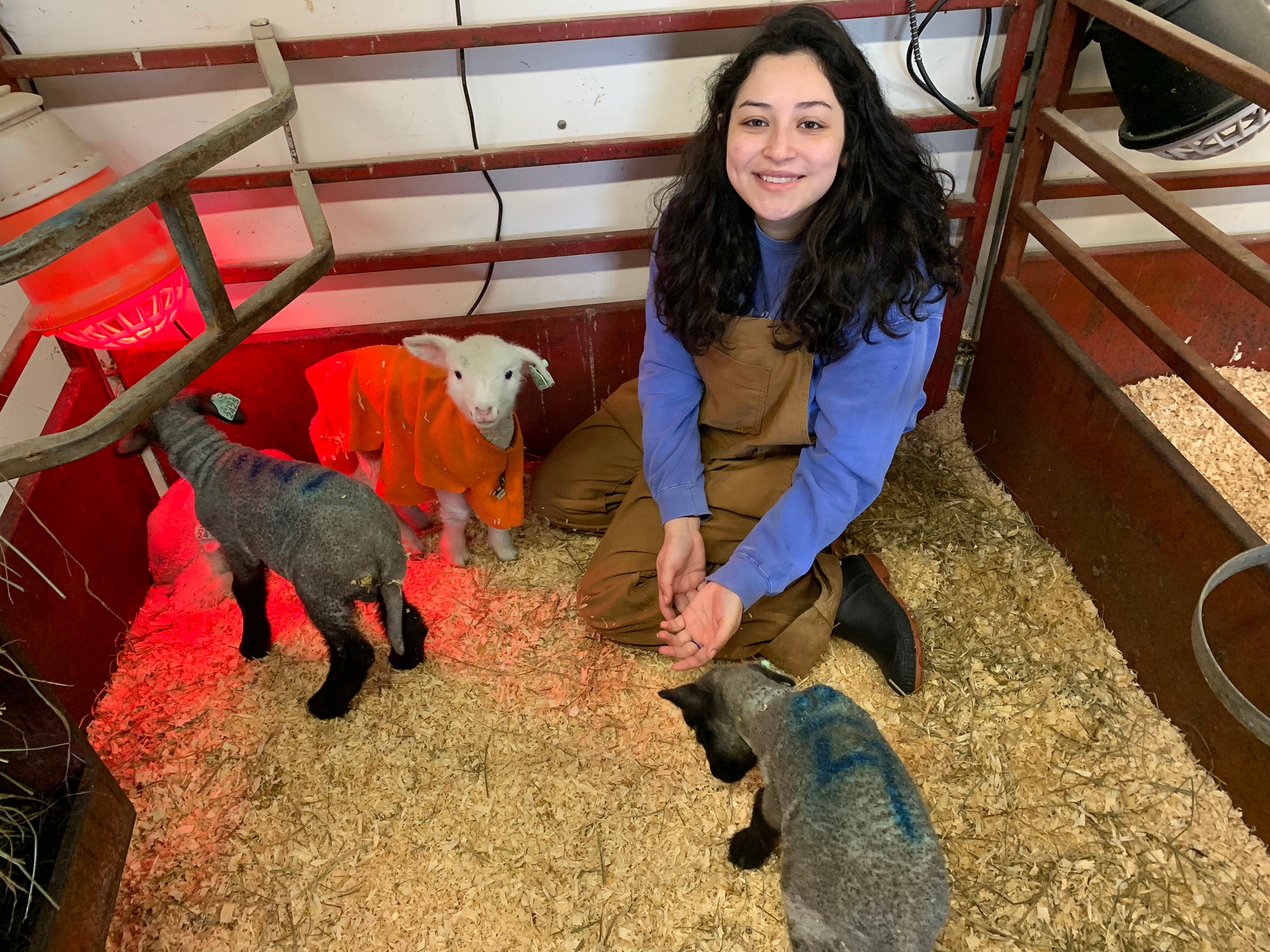KINGSTON, R.I. – – April 19, 2024 — It’s lambing season at the University of Rhode Island’s Peckham Farm, and there are dozens of sheep in their pens. The ewes call out in their loud, baritone voices, and the lambs in their quieter alto bleats. Some of the lambs wander around, poking their curious heads through the fencing, while others follow their mothers, thrusting their heads into their moms’ udders in a demand for milk. Still others are quieter, and huddle under heat lamps or wear little superhero-type capes to ward off the unseasonable chill.

Whether the lambs are particularly active is of great interest to Maya Galeano, a student in the University of Rhode Island’s Honors Program. She’ll be graduating in May with a bachelor’s in animal science. Currently, Galeano is helping research cognitive behavior in lambs.
“I’m working with (Assistant Professor of Animal Science) Maria Peterson this spring lambing season. Some of the ewes have been fed a beta glucan supplement made from mushrooms to see if it has any effects on the ewe’s mothering ability compared to those that did not,” Galeano said.
To do this, Galeano created rubrics. “I wanted to see if the offspring of those ewes had heightened cognitive abilities compared to the ewes that did not receive the beta glucan supplements. I’m looking at how quickly they stand after being born, whether they’re moving around or exploring, whether they’re having trouble breathing, if they pick up suckling quickly or not, and then vocalization. As you’ve heard, it’s plenty loud in there.”
Peterson says Galeano approached her with ideas about testing.
“Maya wanted something having to do with cognitive development of these lambs,” says Peterson. “She knew we were going to be lambing and said, ‘I know that you monitor developmental programming. I’m really curious about what kind of cognitive measurements we could do on these babies.’”
Galeano developed an extensive list of proposed tests, but by the time the approval came to conduct the research, it was too late to do some of the more elaborate ones. This forced her to revamp the procedure. She came up with a rubric and a scoring matrix to evaluate the thriftiness of the lambs once they were born.
“She developed that rubric on her own,” Peterson said. “I kind of Hansel-and-Greteled her there along the path, but she developed this rubric. I would say it is like what humans use for newborn infants. It’s like an APGAR score.”
The research focuses largely on something called developmental programming. The idea is that what the ewes are exposed to while they’re pregnant can impact the baby, whether they are positive or negative factors. Things such as whether the mother has had proper nutrition during pregnancy, or whether she’s been exposed to disease or toxins, can determine how many babies she’s carrying in her uterus. Those are all factors that can affect the offspring and have this developmental programming effect. They can affect the lambs’ growth once they’re born, their immune systems and overall health. And they can also affect their predispositions to disease and productivity later in life.
“So that’s where we’re interested in seeing: if we use this beta glucan, does it potentially have a positive effect on mom through her pregnancy and her lactation, as well as on her babies after she gives birth?” Peterson said.
“We’re really excited about this data,” Peterson said, “because even in the absence of the treatment, it’s helping identify what genetics potentially might be stronger in the flock, what outcomes might be better, because Maya is spending all this time tabulating all this data. She’s also comparing between the breeds because we have the lamb species called the Dorsets and the Shropshires (nicknamed “Shrops”). That’s something else Maya’s going to be doing. It’s not only with the beta glucan treatment, but it’s also the differences between the breeds. The Shrops are brand new breeds, and the farms are really interested to see how they’re developing as well. So, what she’s gathering could potentially shape the whole flock.”
Galeano, who hails from Milton, Massachusetts, has always loved animals, but with her mother’s encouragement, she started out as an astronomy major at a different college. Still, the draw of the heavens was beaten out by the draw of the barn. Galeano researched colleges offering animal science majors, and found URI was the place for her. “You get the hands-on experience that really shows you what the future could be, and what life might be like after.”
This project has helped solidify her interest in continuing in animal sciences. “I already knew that I like learning about research, and how we can improve the lives of animals.”
Galeano will be among other honors students to present their work at the Honors Showcase & Awards Ceremony, Wednesday, May 1, from 9 a.m. to 2 p.m. in Lippitt Hall, 5 Lippitt Road, Kingston Campus. Awards will be presented from 2:30 to 3:30 p.m.
This story was written by Hugh Markey.

